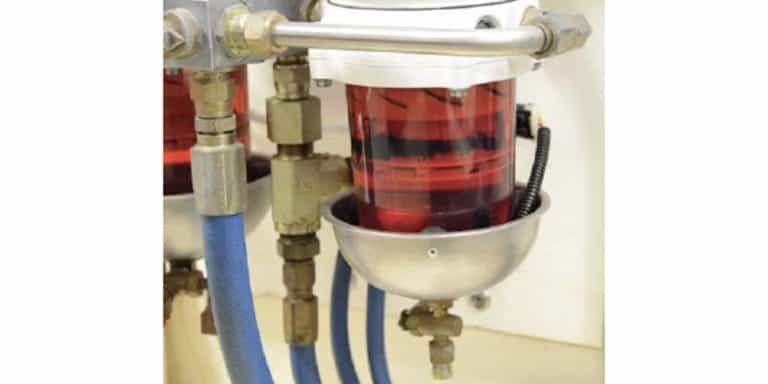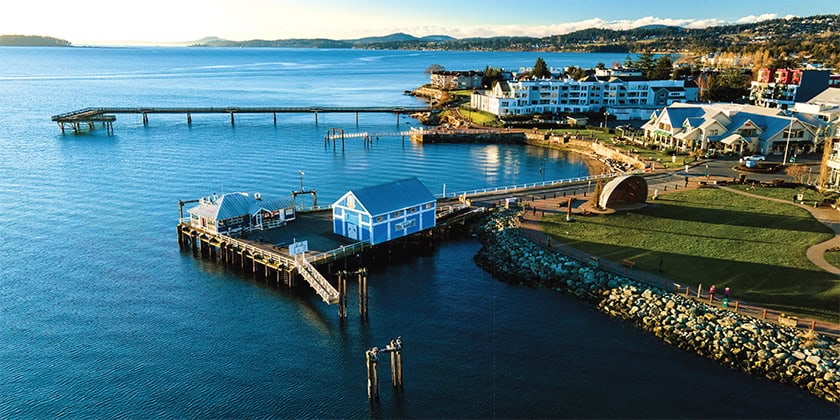What to Check Before Casting Off for the start of Summer
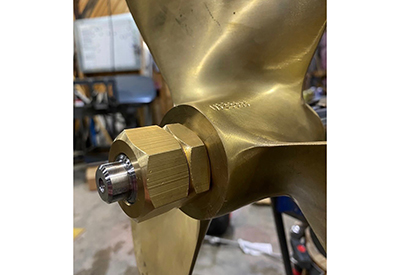
By Andrew McDonald
Your Pre-departure Checklist – avoid problems before casting off
Gilligan’s Island was one of the first pseudo-boating TV programs that I saw as a kid. Most of us know the premise; a three-hour tour that didn’t end well. But, they made it seem like a lot of fun. The island wasn’t awful. There were adventures, comradery, special guests and pretty girls.
Prop nuts should be secured and double-checked
The opening credits tell us that a typhoon derailed the cruise, blowing them off course and bringing us to the current predicament. As a kid, you buy it; it’s plausible in a tv-land sort of way. But something always nagged at me; how did Captain Jonas Grumby spend the morning before casting off? The show never describes it. They don’t show a checklist, nor do they detail his preparations. We the viewers, don’t really know what the state of the engine room was on that fateful morning – nor do we know how much attention to detail Gilligan paid to routine maintenance.
What could The Skipper have checked before departure? Let’s begin by pretending that the 38’6” Wheeler is based in a Canadian port. Lights. Camera. Action.
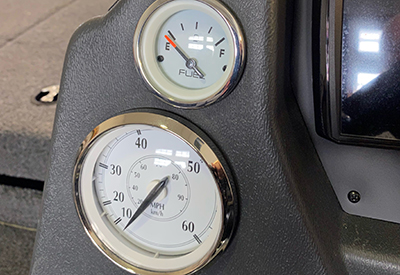 The camera zooms in on a clipboard loaded with multiple checklists.
The camera zooms in on a clipboard loaded with multiple checklists.
Fuel should be topped up and the gauge checked to confirm that it is reading accurately
The top sheet, labelled ‘Pre-launch check’ details what to check before launching (whether once in the spring, or each time off of a trailer), there are two overarching concerns:
- Is the boat water-tight?
- Are all underwater components (that can’t be reviewed or addressed once launched) accounted for and functional?
Before launching, the following should be checked:
- Verify that the hull drain plug is fitted and secure. I find a thread-sealant to be helpful, (especially for brass fittings) and I prefer a cream-style sealant as opposed to Teflon tape.
- Check that all anodes are present, secure and in serviceable condition
- Hull: Check the state of the hull and ensure that there are no cracks, damage, exposed fibreglass, broken rivets, etc. If any damage is present, have it repaired prior to launch.
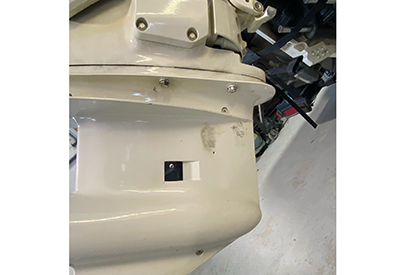 Underwater Machinery: Check the underwater machinery and ensure that it all functions correctly; check the trim tabs, engine trim, sterndrive/outboard gear oil and bellows condition, underwater lights, etc.
Underwater Machinery: Check the underwater machinery and ensure that it all functions correctly; check the trim tabs, engine trim, sterndrive/outboard gear oil and bellows condition, underwater lights, etc.- Propeller: Check the propeller – ensure that the propeller hub (if fitted) is in good shape, and that the retaining nut(s) and cotter pins are torqued to specification.
- Through-hulls: Check any/all through-hulls and transducers for integrity, and confirm that all seacocks can be accessed, opened and closed. Check to ensure that any/all screens covering through-hulls are clear of debris Also confirm that bungs are available to seal any through-hulls that are damaged underway.
- Bilge Pumps: Confirm that all bilge-pumping arrangements (both electric and manual pumps) are functional and are of sufficient capacity…
- Standing rigging: Are mast, shrouds, lifelines, spreaders, shackles, pins, cleats and latches in good working order? Will strains cause any components to fail? Pre-launch is the time to verify and repair.
Gear lube drain and vent plugs should be checked for tightness, and with a plug gasket in place, should be flush with the lower unit housing
Gilligan happily checks off the list and The Minnow is ready to launch. Let’s imagine, through the magic of television, that she is now swinging safely at her mooring. The pre-launch checklist is complete, and all is ship-shape. Thurston Howell III calls the marina to confirm his party’s departure time, and Captain Grumby and Gilligan begin working through the pre-departure checklist. Before casting off, they read that they should check:
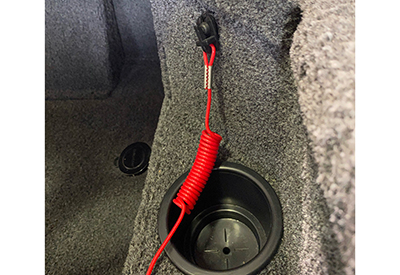 Hull: now that the boat is in the water, is any water coming in? if so, what is the source? Can it be mitigated or repaired? Is the boat sitting level in the water?
Hull: now that the boat is in the water, is any water coming in? if so, what is the source? Can it be mitigated or repaired? Is the boat sitting level in the water?- Fuel: are fuel tanks topped up? Is the fuel fresh, and has a biocide or stabilizer been added? Does the fuel gauge read accurately? Are reserve tanks available and operable?
- Lines/Anchor: Are all the boat’s lines and rigging in serviceable condition? Is the anchor accessible, secured and the rode and shackles in good condition?
- Is running rigging in good condition, with sheets labelled and accessible?
- Tools/spare parts: do you have tools to complete basic repairs? Do you have spare parts (light bulbs, fuses, lubricants, impellers, belts, etc.)?
the safety lanyard should be secured and confirmed operational before leaving dock
The Skipper should hang up his hat, enter the engine room and spend some time devoted to the mechanical and electrical systems checklist:
- Engine check – engine off: Are all engine fluids clear and at the correct level? This might include: engine oil, power steering fluid, gear lube reservoir, coolant, transmission oil. Are any/all filters tight and secure? Are belts showing any wear? Are they tight and fitted? Are all cables and wire harnesses secure and connected well?
- Engine check – engine on: Does the engine turn on and off as designed? Does cooling water run through the engine and out through the exhausts? Does the engine come up to temperature? Does the engine shift well from neutral to forward and reverse? Do all hydraulic trim systems move freely? Are there any drips, sounds, smells or movement that isn’t normal?
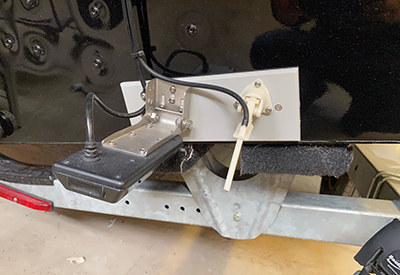 Battery check: Is the battery fully charged? Will the engine start easily when disconnected from shore-power? When the engine is running, does the alternator charge the battery?
Battery check: Is the battery fully charged? Will the engine start easily when disconnected from shore-power? When the engine is running, does the alternator charge the battery?- Electrical system check: Does the battery selector switch allow you to toggle between the engine and house batteries? When starting the engine, the ‘starter’ battery should be used, and when electronics are being used with the engine off, the ‘house’ battery should be used, keeping the starter battery in reserve
- Pumps: confirm that all pumps, (bilge, livewell, recirculation, water, and transfer pumps) are working.
- Are ‘comfort’ systems functioning well? Check: Air conditioning, pressurized water, hot water tanks, cabin heat, ventilation and fans…
- Navigation: are all electronic navigation instruments on and functional? Are GPS, AIS and Radar reading correctly? In case of electrical failure, are charts and a compass available and working?
- Communication: Is the VHF system working correctly? Are cell/sat phones available and are backup charging systems functional? As a last-ditch resort, are horns, bells, or other sound-signalling appliances available?
- Speedo pick-ups, transducers and anodes should be checked to ensure that they are secure and functional before launching
The last checklist on Gilligan’s clipboard is the safety system’s check:
- Neutral safety switch: mounted on the engine, this ensures that the vessel can’t be started while in gear
- Emergency tether: mounted near the helm, this device shuts the engine down immediately when disconnected. The operator should wear the tether clipped in place. It should be tested and confirmed working.
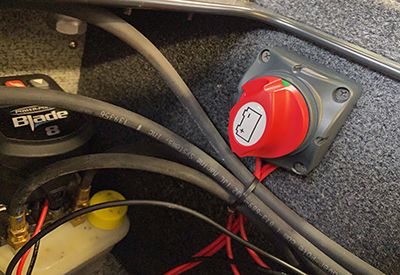 Engine shut-off: will the engine shut off with the key switch? If not, is there a separate emergency shut-off available, and is it accessible and labelled?
Engine shut-off: will the engine shut off with the key switch? If not, is there a separate emergency shut-off available, and is it accessible and labelled?- Communications: This was detailed on our last list – but it bears checking a second (or third) time: Can your vessel communicate effectively with other vessels, and with shore?
- Fire suppression systems: are fire extinguishers mounted and accessible (per Transport Canada standards)? Have any fixed fire suppression systems been checked and tested? Have any/all fire hazards been reviewed and corrected?
Battery switches should be confirmed operable before casting off
Could the disaster of the SS Minnow have been averted before casting off? We’ll never know. But, perhaps through good planning and seamanship, we can ensure that any 3-hour tours leaving Canadian waters in 2022 won’t reach the same fate (unless you’re intending to spend the equivalent of 98 episodes on a deserted island.) In which case – Enjoy!

